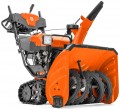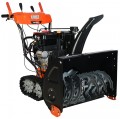Snow height
The maximum thickness of the snow layer that the snow blower removes in one pass. If you plan to regularly remove snow as it falls in a small area (for example, in the courtyard of your own private house), a grip height of up to 20 cm will be enough. If the opportunity to remove snow is rare (for example, in a country house where you visit only on weekends), you should pay attention to more powerful models with a height of about 50 cm.
Max. throw distance
The maximum distance to which the snow blower can throw the collected snow (for models without throwing distance adjustment, the operating range itself). This value is rather arbitrary, since snow can be strongly dispersed in flight. Nevertheless, it characterizes the capabilities of the unit well and allows you to compare it with other models.
Long range is important mainly when working on large areas — it allows you to throw snow across the cultivated area so that it does not have to be collected a second time. As for specific figures, the value
up to 10 m is considered relatively small,
11 – 15 m — average, and in the most "long-range" models this figure can be
16 m or more.
Number of gears
The number of gears in the transmission of a self-propelled snow blower (see "Design"), in fact — the number of speeds at which it can move during operation.
Recall that upshifting increases speed and reduces torque. Thus, high gears are convenient for working with loose snow, which does not give strong resistance, while low gears allow you to cope with dense snow and crust. And the greater the number of gears, other things being equal, the more accurately you can choose the optimal speed. On the other hand, the abundance of settings complicates and increases the cost of the transmission. Therefore, when choosing the number of gears, manufacturers also take into account the overall level of the snow blower: the more powerful and heavier the unit, the more settings it usually provides.
A separate case are units with continuously variable (including hydrostatic) transmissions. They do not have fixed gears, and the gear ratio is automatically adjusted depending on the throttle position and the load on the working nozzle. One of the advantages of such systems is the almost zero probability of slipping, because. the wheels keep the torque at all times. In addition, the transmission itself can play the role of overload protection: when the auger is jammed, it disconnects it from the engine. On the other hand, stepless systems are quite complex and expensive, and automation does not always work exactly the way the user wants; therefore, this option is relatively rare.
Transmission
the "gearbox" is responsible for selecting the speed of the snow blower. The ability to move in a wide range of speeds will come in handy to reduce fuel consumption, increase the efficiency of clearing the territory from snow and improve the manoeuvrability of equipment when working in hard-to-reach places. Usually, modern snow blowers provide up to 6 speeds for moving forward and 1 – 2 reverse gears.
— Mechanical. Mechanical step transmission means manual switching of speeds from the operator's control panel. This type of gearbox is installed on the vast majority of snowplows. In order to avoid premature failure of the transmission on the “mechanics”, the gears should be switched sequentially after the equipment has completely stopped.
- hydrostatic. An analogue of the variator in cars. Allows you to smoothly switch the speed of the snow blower through the use of hydraulic oil. The gear change is stepless, when switching gears, the equipment does not need to be stopped. The continuously variable hydraulic transmission makes the snow blower extremely easy to move.
- Friction disc. The friction disc ensures the synchronous operation of the snowplow wheels. Structurally, this assembly resembles a disk-shaped part with a rubber seal put on it. The unit maintains the simultaneous rotation of the standard snow blower wheels at the speed that was set by the operator using the gear lever.
Motor type
Model of the engine installed in the snow blower.
With this information, you can find detailed data on the engine — from official specifications to reviews, reviews and advice on specific nuances. In this way, you can evaluate how a snow blower with this particular engine will suit your needs.
Motor power
Snowblower motor power in horsepower.
The universal unit of power today is watts, but for petrol and diesel engines (see "Motor type"), the traditional designation in horsepower may also be given. 1 HP approximately equal to 735 watts.
The higher the motor power, the higher the performance of the snow blower, the better it handles with high dense snowdrifts and icy crust. However, more powerful engines consume more fuel, weigh more and cost more, and their use is not always justified. Detailed recommendations on choosing the optimal power for a specific situation can be found in special sources.
Motor power
Snowblower motor power in watts. This designation is used for all electric models; for units with an internal combustion engine (see "Motor type"), the designation in horsepower may also be given (see above).
The higher the motor power, the higher the snowblower's flow rate, the better it copes with high dense snowdrifts and icy crust. However, more powerful engines consume more fuel, weigh more and cost more, and their use is not always justified. Detailed recommendations on choosing the optimal power for a specific situation can be found in special sources.
Fuel tank volume
The amount of fuel that the snow blower tank can hold at one time. Knowing this figure, as well as fuel consumption (see above), you can easily calculate the approximate operating time on one gas station. However, manufacturers usually choose the volume so that the operating time reaches at least 2 – 2.5 hours, so in most cases you can not pay much attention to this parameter.
Starter
The method of starting motor (see "Motor type") of petrol snow blower. Today, the following options are available:
— Manual (starter rope). The simplest way to start: the operator pulls the cable, which turns the shaft and gives the engine the necessary initial impulse. Such starting systems are the most compact, simple and inexpensive, and they do not depend on power sources. On the other hand, it makes sense to use cables mainly in light and low-power snow blowers - to start heavy units, significant force is required, which is easier to provide with an electric starter.
—
Electric starter (230 V mains). Starting with an electric starter powered by a 230 V network (a regular socket). An electric starter is a small electric motor that turns the engine shaft when starting, giving it an initial impulse. Such systems are more complex, heavier and more expensive than cables, but are suitable even for the heaviest and most powerful engines; and the start itself is extremely simple - the user only needs to press a button. At the same time, power from the network allows you to do without heavy and expensive batteries. True, the network itself is required for starting, but this usually does not cause any special problems; and in case the snow blower stalls "in an open field", a backup starting system is usually provided in the form of the same cable. Therefore, most units with electric starters use power from the network.
...
— Electric starter (battery). Starting with an electric starter powered by a battery installed in the snow blower. For general features of electric starters, see above, and battery power makes the starting system as autonomous as possible: the starter can be used regardless of the presence of sockets nearby, and the battery is recharged from the running engine if necessary. On the other hand, the presence of a battery affects the cost and weight of the unit, and the mentioned autonomy is required relatively infrequently. Therefore, electric starters on batteries are used only in certain models of high-performance snow blowers designed for long-term operation "in the field", away from power grids; the weight and price of the battery in such cases are insignificant compared to the weight and price of the unit itself.
